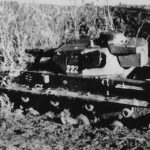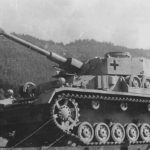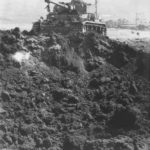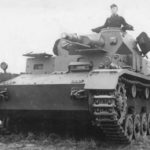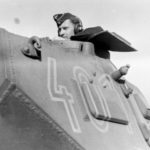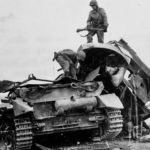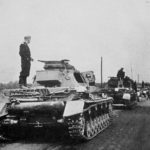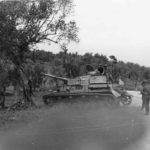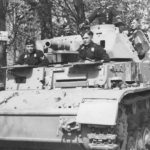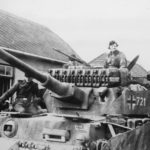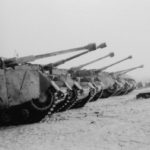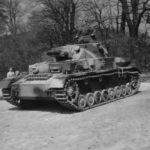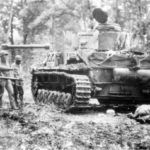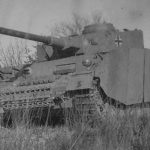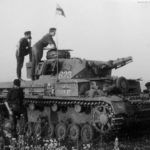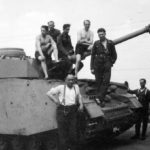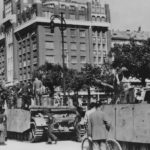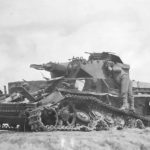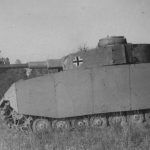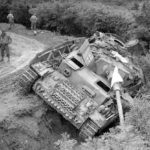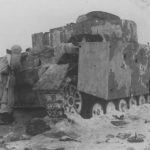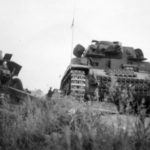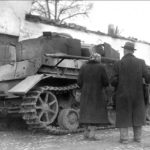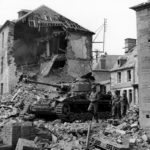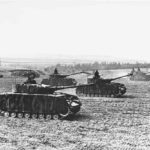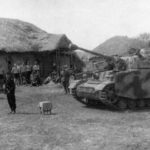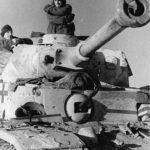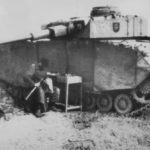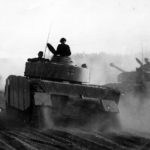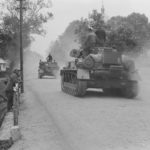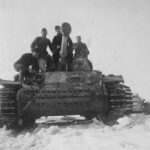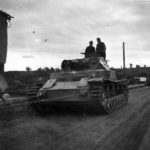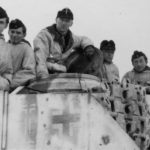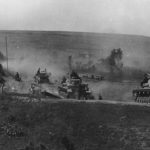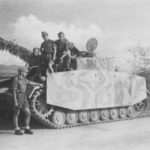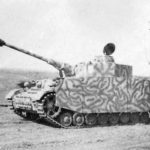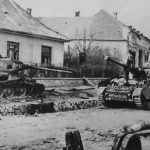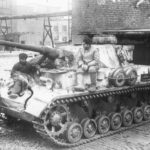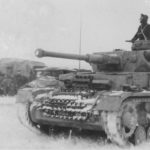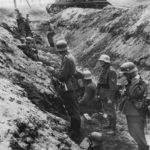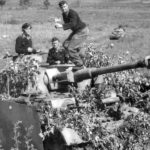German tanks in Aberdeen Proving Ground 1943
Crew atop an Uparmoured Panzer IV Ausf E
Destroyed Panzer IV and III tanks near Stalingrad Winter of 1943
Panzer IV Ausf G tanks 3
Destroyed Panzer IV 13
45th Division Troops pass KO’d Panzer IV Ausf, G at Salerno, 1943
Panzer IV Ausf H, Western Front
Panzer IV Ausf C tanks, The Polish Campaign 1939
Early Panzer IV coded 222
Panzer IV Rhodos
Panzer IV of the 2nd SS Panzer Division “Das Reich, March 1943
German troops and Panzer IV advancing in Poland, September 1939
Panzer IV Ausf D 321, 1940
Panzer IV Ausf G 2
Panzer IV Ausf H Ukraine, 1944
Whitewashed Panzer IV
Panzer IV Ausf. D “Vorpanzer”
Panzer III and IV Ausf G
Panzer IV Ausf. A September 1939
Panzer IV Ausf F tanks loaded onto a rail cars for transport
Uparmoured Panzer IV Ausf E 3
Panzer IV code 801
Panzer IV camouflaged in white, Eastern Front 1943
Panzer IV Ausf G tanks in Rome 1944
Panzer IV Ausf. G 15
Panzer IV Ausf. B move along a dirt road
Panzer IV code 401 of the Panzerregiment 35
Panzer IV Ausf G code 712 of 1. Panzer Division in Greece
Panzer IV Ausf D 60 and 38(t) of the 20. Panzer Division
Panzer IV Ausf G tanks Winter
Panzer IV Ausf G 5
Panzer IV Ausf. D 4
Panzer IV Ausf A 1939
Factory-fresh Panzer IV Ausf E
Body German soldier by Knocked Out Panzer IV in Sicily, 1943
Panzer IV Ausf H code 604
Destroyed Panzer IV Ausf J with Thoma Drahtgeflecht Schurzen
Panzer IV blown up at Wirtsfeld, Belgium Battle of the Bulge 17 December 1944
Early Panzer IV 631
Panzer IV Ausf E code 92
Panzer IV Ausf. G of the 20. Panzer-Division, Winter
Panzer IV 413 and Italian soldier surrenders to Jawan
New Panzer IV Ausf C of the Pz Regiment 11
Panzer IV with Ostketten
Panzer IV Ausf G front view
Panzer IV Ausf G Italy 1944
Uparmoured Panzer IV Ausf D of the Fallschirm-Panzer-Feldersatz-Bataillon 1 Fallschirm-Panzerdivision Hermann Goring Holland, July 1944
Captured Panzer IV code 837, 1944
Panzer IV Ausf C 412
Panzer IV Ausf H 1944 3
Panzer IV 508 from Waffen SS unit
Column of German Panzer IV Ausf G tanks
Panzer IV 721
Panzer IV Ausf G tanks in Greece 1943
Panzer IV Ausf H from 2. SS-Panzerdivision “Das Reich”
Late Panzer IV tanks
Panzer IV Ausf H Eastern Front Winter 1944
Panzer IV powered by Stadtgas cylinders
Panzer IV Ausf H 831
Destroyed Panzer IV in Bastogne 1944
Panzer IV Ausf G rear view
Bulgarian Panzer IV Ausf G
Panzer IV 619
Panzer IV of the 23. Panzer-Division, Hungary 1945
Panzer IV Ausf F1
Panzer IV France 11 October 1944
Panzer IV Ausf G 6
Panzer IV of the Pz Regiment 31
Panzer IV Ausf E 80826
Panzer IV 112
Panzer IV Ausf H front view
Destroyed Panzer IV Ausf H 1945
Panzer IV 823 of the 24. Panzer-Division
Panzer IV Ausf G from Waffen SS
Destroyed Panzer IV Ausf C France 1940
Panzer IV Ausf H 4
Panzer IV of the 23. Panzer-Division, Hungary 1945 2
Panzer IV Ausf. D 422 of the 4. Panzer-Division
Panzer IV Ausf E of the 3. Panzer-Division 1941
Panzer IV Ausf H tanks in Trieste 1943
U.S. soldier pokes his head inside a knocked out tank near Bir Marbott in Tunisia 1943
Panzer IV Ausf H side view
Panzer IV Ausf H tanks 3
Panzer IV code 301
Destroyed Panzer Ausf H Italy 1944
Panzer IV of the 12. Panzer Division Eastern Front
Destroyed Panzer IV Kharkov 1943
Panzer IV Ausf H
Destroyed Panzer IV Ausf H Eastern Front, Winter
Body of crewman by Knocked Out Panzer IV 414 1942, North Africa
Panzer IV Ausf G 721 of the 1. Panzer-Division, Greece 1943
Panzer IV Ausf E from 20. Panzer-Division 1941
Panzer IV Ausf G column
Panzer IV Ausf. C of the 7. Panzer-Division 1940
Panzer IV mud
Panzer IV Ausf D of the of the 7. Panzer-Division 1940
BW I V1 in Krupp plant 1936
Panzer IV Ausf D/G refurbished
Panzer IV Ausf. F1
Panzer IV from 1st SS Panzer Division Leibstandarte SS Adolf Hitler, Hungary 1945
Italian Panzer IV Ausf G from of the 1. Divisione corazzata CCNN “M”
Panzer IV and II tanks near Boulogne 1940
Panzer IV Ausf C code 612, Poland 1939
Panzer IV Ausf J with Thoma schürzen Eastern Front
Destroyed Panzer IV Ausf G of the Afrika Korps 1943
Panzer IV Ausf G tanks Winter
Panzer IV code 713
Destroyed Panzer IV Ausf F2 1942
Wrecked Panzer IV in Pontfaroy, France on August 3, 1944
Panzer IV Ausf H tanks 1944
Soviet Panzer IV Ausf G
Panzer IV 301 3
Panzer IV Ausf F2
Panzer IV Ausf H in Wassiljewka Ostfront
Panzer IV Ausf C code 414 1939 2
Panzer IV 323 with trailer
Panzer IV code 222 Kurland 1945
Panzer IV Ausf H Winter
Panzer IV Ausf J with Thoma Schurzen , Eastern Front
Panzer IV Ausf G Ostfront
Panzer IV Ausf F 4
Panzer Ausf H of the PzRgt 35, 4. Panzer-Division
Up armoured Panzer IV
Panzer IV Ausf D of DAK
Panzer IV Ausf G DAK
Panzer IV Ausf G tanks 2
Panzer IV Ausf G Italy Summer 1944
Panzer IV Ausf H Korsun Pocket 1944
Panzer IV Ausf H tanks Eastern Front
Panzer IV Ausf H 732
Panzer IV Ausf D 3
Panzer IV D tanks from 9. Panzer-Division Ukraine 1941
Panzer IV Ausf H Eastern Front North 1944
Panzer IV Ausf B 411
Panzer IV lang Ukraine 1943
Panzer IV Ausf C of the 1st Panzer-Division France 1940
Panzer IV with Winterketten
Destroyed Panzer IV Ausf H Eastern Front
Damaged Panzer IV 614 on trailer
Panzer IV 1939 3
US Troops advance past knocked out Panzer IV in Italy 1943
Panzer IV Ausf D of the DAK 2
Panzer IV Ausf H Eastern Front 2
Italian Panzer IV G from of the 1. Divisione corazzata CCNN “M”
Panzer IV Ausf H, Winter Eastern Front
Panzer IV Ausf H Eastern Front, 7
Panzer IV Ausf G with Winterketten Ostfront 1943
Panzer IV of the Panzer-Regiment 35
Panzer IV Ausf C passing trucks on road
Panzer IV Ausf G of the 16. Panzer-Division Stalingrad 1942
Panzer IV of the Panzer-Regiment 35 5
Panzer IV Ausf H code 1041
Panzer IV Ausf H 16
Panzer IV and destroyed T-34/85
Captured Panzer IV Ausf G 1943 Stalingrad
Panzer IV Panzer-Regiment 35 4
Panzer IV Ausf D Afrika DAK
Destroyed Panzer IV Ausf C 1940
Captured Panzer IV Ausf H code 831
Panzer IV F lang
Panzer IV Aysf E 332 Ukraine 41
Panzer IV Ausf G Abandoned at Palermo Sicily 24 September 1943
Panzer IV F2 Eastern Front 1942
Camouflaged Panzer IV Ausf G
PzKpfw IV Ausf H of the 10th SS Panzer Division Frundsberg
Knocked Out Panzer IV in Capo d’Orlando Sicily 1943
Panzer IV Ausf C with Schurzen
Panzer IV Ausf D Panzer-Regiment 35 2
Panzer IV Ausf F tanks
5 Panzer-Regiment Panzer IV Ausf D Eastern Front
Panzer IV Ausf G 7
Panzer IV 902 and Panzers II
Panzer IV Ausf H side view 4
Panzer IV Ausf G Eastern Front 1943
Panzer IV destroyed by ISU-152
The Panzerkampfwagen IV was a tank developed by Nazi Germany and used extensively in World War II. It was designed initially as an infantry-support medium tank, to work in conjunction with the anti-tank Pzkpfw III. Later in the war, it was up-gunned and up-armored, and took over the tank-fighting role. The Panzer IV was the most common German tank of World War II, and was used as the base for many other fighting vehicles, such as tank destroyers and self-propelled antiaircraft guns. By the end of the war nearly 8600 had been built.
The Panzer IV was the workhorse of the German tank corps, being produced and used in all theatres of combat throughout the war. The design was upgraded repeatedly to deal with the changing threats from enemy forces.
On January 11, 1934, following specifications laid down by Heinz Guderian, the Army Weapons Department drew up plans for a medium tank with a maximum weight of 24,000 kg and a top speed of 35 km/h. It was intended in a support and anti-infantry role, using a low-velocity, large-caliber gun firing high-explosive shells. It was not required to deal with enemy tanks on equal terms.
Krupp, Rheinmetall, and MAN all produced prototypes, which were tested in 1935. As a result of the trials, the Krupp design was selected for full-scale production. The first Panzer IV A came off the assembly line in October of 1937, with a total of 35 being produced over the next six months.
Between 1937 and 1940, attempts were made to standardize parts between Krupp’s Panzer IV and Daimler-Benz’s Panzer III.
The Panzer IV was originally intended principally to deal with infantry and fortifications, while the Panzer III dealt with enemy armoured units. To this end it was equipped with the 75 mm KwK 37 L/24 gun, which was effective against soft targets but lacked much armour penetration. It had poor accuracy, because the barrel was very short (1800 mm), giving a low muzzle velocity. For comparison the L/48 Gun is 3600 mm long.
Combat experience showed that increasingly the 50 mm L/60 gun mounted on late-model Panzer III was unable to deal with enemy tanks at long range. Panzer IIIs struggled against T-34s of the Soviet Union and M4 Shermans of the United States, both of which had guns in the 75 or 76 mm calibre.
The Panzer IV’s design already mounted a 75 mm gun and it was the obvious choice for the next medium tank development. As the Wehrmacht needed a tank with good anti-tank capabilities to deal with the T34, the production of the Panzer IV model F was changed to an improved model with a redesigned turret carrying a new, more powerful 75 mm L/43 anti-tank gun. The sprocket and idler wheels were altered to take wider tracks more able to support the increased weight of a larger gun. This required a change in naming conventions: the old 75mm L24-equipped Pz-IV F was renamed Pz-IV F1, and the new 75mm L/43-equipped was named Pz-IV F2. The Pz-IV F2 was later renamed Pz-IV G and production continued under this name with minor improvements. In late 1942 the Pz-IV G gun was upgraded to the even longer 75 L/48 gun. Early model Panzer IV tanks were often upgraded for increased combat efficiency. From 1943, for example, surviving Panzer IV models E/F were given additional armor and the 75 L48 gun.
The aforementioned upgrades allowed the Panzer IV to keep pace with newer designs such as the Sherman and the T-34. Production continued and was stepped up even while the more effective Panther medium tank was in service, because of the Panzer IV’s low cost and greater reliability.
Small numbers of Panzer IV were supplied by Germany to its allies. Bulgaria received 88 vehicles and used them against Germans in late 1944. Finland bought 15 Panzer IV Ausf Js, which arrived too late to fight against the Soviets the Continuation War (1941-44) or against German troops in the following Lapland War (1944-45) and served as training vehicles until 1962. Small numbers were also given to Hungary, Romania, Spain and Yugoslavia (Chetniks). In 1950s/1960s Syria bought several dozens of Panzer IVs from USSR, France, Czechoslovakia and Spain and employed them in the 1965 conflict over Jordan headwaters (often referred to as Water War) and in the Six Days War (1967).
The Panzer IV A had 15 mm of slightly sloped homogenous steel armor on all sides, with 10 mm of armor on the top and 5 mm on the bottom. This was deemed sufficient, as the Panzer IV was intended for anti-infantry work, while Panzer IIIs were to deal with opposing tanks. In practice, Panzer IVs would frequently face enemy tanks and anti-tank guns unsupported, and the armor was upgraded to 30 mm on the front hull of the Panzer IV B, 50 mm in the IV E, and 80 mm in the IV H, with armor on the sides and rear being increased as well. Panzer IVs frequently had armor skirting or additional layers of armor added in the field. As the Panzer IV was intended to fill an anti-infantry combat role, early models were fitted with a low-velocity 75 mm KwK 37 L/24 gun, firing high-explosive shells. After the Germans encountered the Soviet T-34, the Panzer IV F2 and G were armed with the high-velocity 75 mm KwK 40 L/43 anti-tank gun. Later IV G models, and all subsequent Panzer IVs, were armed with the longer 75 mm KwK 40 L/48 anti-tank gun.
All models of the Panzer IV had a 7.92 mm coaxial machine gun mounted in the turret, and all except the IV B and IV C had a second 7.92 mm gun in the hull. The Panzer IV A was powered by a 230 hp (172 kW), 12-cylinder Maybach HL 108 TR engine, giving a top speed of 30 km/h and a range of 150 km. All later models were powered by the 320 hp (239 kW), 12-cylinder Maybach HL 120 TRM engine. Top speed varied among models, depending on the transmission (which was made by ZF), armor, and gun, but was around 40 km/h. The range was generally around 200 km.
Like all of Germany’s World War II tanks, the Panzer IV used gasoline (petrol).








